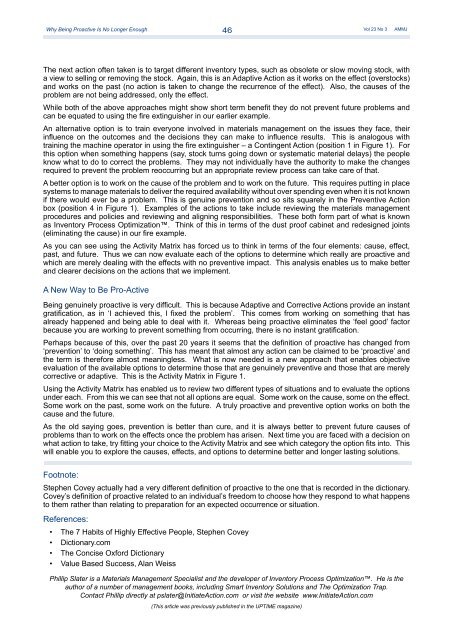SKF Reliability Systems - Library
SKF Reliability Systems - Library
SKF Reliability Systems - Library
You also want an ePaper? Increase the reach of your titles
YUMPU automatically turns print PDFs into web optimized ePapers that Google loves.
Why Being Proactive Is No Longer Enough<br />
The next action often taken is to target different inventory types, such as obsolete or slow moving stock, with<br />
a view to selling or removing the stock. Again, this is an Adaptive Action as it works on the effect (overstocks)<br />
and works on the past (no action is taken to change the recurrence of the effect). Also, the causes of the<br />
problem are not being addressed, only the effect.<br />
While both of the above approaches might show short term benefit they do not prevent future problems and<br />
can be equated to using the fire extinguisher in our earlier example.<br />
An alternative option is to train everyone involved in materials management on the issues they face, their<br />
influence on the outcomes and the decisions they can make to influence results. This is analogous with<br />
training the machine operator in using the fire extinguisher – a Contingent Action (position 1 in Figure 1). For<br />
this option when something happens (say, stock turns going down or systematic material delays) the people<br />
know what to do to correct the problems. They may not individually have the authority to make the changes<br />
required to prevent the problem reoccurring but an appropriate review process can take care of that.<br />
A better option is to work on the cause of the problem and to work on the future. This requires putting in place<br />
systems to manage materials to deliver the required availability without over spending even when it is not known<br />
if there would ever be a problem. This is genuine prevention and so sits squarely in the Preventive Action<br />
box (position 4 in Figure 1). Examples of the actions to take include reviewing the materials management<br />
procedures and policies and reviewing and aligning responsibilities. These both form part of what is known<br />
as Inventory Process Optimization. Think of this in terms of the dust proof cabinet and redesigned joints<br />
(eliminating the cause) in our fire example.<br />
As you can see using the Activity Matrix has forced us to think in terms of the four elements: cause, effect,<br />
past, and future. Thus we can now evaluate each of the options to determine which really are proactive and<br />
which are merely dealing with the effects with no preventive impact. This analysis enables us to make better<br />
and clearer decisions on the actions that we implement.<br />
A New Way to Be Pro-Active<br />
Being genuinely proactive is very difficult. This is because Adaptive and Corrective Actions provide an instant<br />
gratification, as in ‘I achieved this, I fixed the problem’. This comes from working on something that has<br />
already happened and being able to deal with it. Whereas being proactive eliminates the ‘feel good’ factor<br />
because you are working to prevent something from occurring, there is no instant gratification.<br />
Perhaps because of this, over the past 20 years it seems that the definition of proactive has changed from<br />
‘prevention’ to ‘doing something’. This has meant that almost any action can be claimed to be ‘proactive’ and<br />
the term is therefore almost meaningless. What is now needed is a new approach that enables objective<br />
evaluation of the available options to determine those that are genuinely preventive and those that are merely<br />
corrective or adaptive. This is the Activity Matrix in Figure 1.<br />
Using the Activity Matrix has enabled us to review two different types of situations and to evaluate the options<br />
under each. From this we can see that not all options are equal. Some work on the cause, some on the effect.<br />
Some work on the past, some work on the future. A truly proactive and preventive option works on both the<br />
cause and the future.<br />
As the old saying goes, prevention is better than cure, and it is always better to prevent future causes of<br />
problems than to work on the effects once the problem has arisen. Next time you are faced with a decision on<br />
what action to take, try fitting your choice to the Activity Matrix and see which category the option fits into. This<br />
will enable you to explore the causes, effects, and options to determine better and longer lasting solutions.<br />
Footnote:<br />
Stephen Covey actually had a very different definition of proactive to the one that is recorded in the dictionary.<br />
Covey’s definition of proactive related to an individual’s freedom to choose how they respond to what happens<br />
to them rather than relating to preparation for an expected occurrence or situation.<br />
References:<br />
• The 7 Habits of Highly Effective People, Stephen Covey<br />
• Dictionary.com<br />
• The Concise Oxford Dictionary<br />
• Value Based Success, Alan Weiss<br />
46<br />
Phillip Slater is a Materials Management Specialist and the developer of Inventory Process Optimization. He is the<br />
author of a number of management books, including Smart Inventory Solutions and The Optimization Trap.<br />
Contact Phillip directly at pslater@InitiateAction.com or visit the website www.InitiateAction.com<br />
(This article was previously published in the UPTIME magazine)<br />
Vol 23 No 3 AMMJ

















